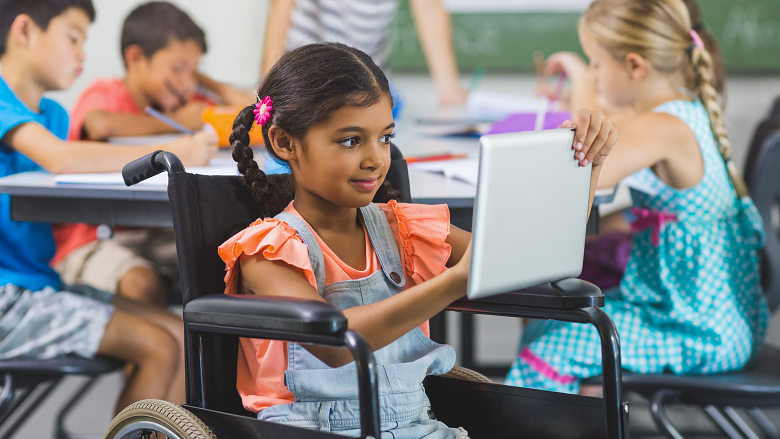Inclusive Education for Children with Disabilities

Inclusive education is an approach that seeks to ensure that all students, regardless of their abilities, are included in regular classroom activities and are able to participate fully in the educational process. Inclusive education is particularly important for children with disabilities, who have traditionally been excluded from mainstream educational settings. Inclusive education benefits not only children with disabilities but also their peers, teachers, and communities.
Importance of Inclusive Education for Children with Disabilities
Inclusive education is essential for children with disabilities because it allows them to access the same opportunities as their peers. It promotes their social, emotional, and academic development by providing them with the support and resources they need to succeed. Inclusive education also helps to break down the barriers and stereotypes that can lead to discrimination and exclusion.
Challenges Facing Inclusive Education
Despite the benefits of inclusive education, there are several challenges that must be overcome in order to make it a reality. Attitudinal barriers, such as negative attitudes towards disability, can make it difficult to create a welcoming and inclusive classroom environment. Resource constraints, such as limited funding and lack of access to assistive technology, can also make it difficult to provide the necessary support to students with disabilities. Teachers may lack the training and support they need to effectively teach students with disabilities, and some parents may be resistant to the idea of inclusive education.
Best Practices in Inclusive Education
There are several best practices that can help to overcome the challenges facing inclusive education. Universal design for learning is an approach that seeks to create learning environments that are accessible to all students, regardless of their abilities. Collaborative teaching involves co-teaching between a general education teacher and a special education teacher, which can help to provide more individualized support to students. Assistive technology, such as text-to-speech software or electronic magnifiers, can help to level the playing field for students with disabilities. Individualized education plans (IEPs) are also a key component of inclusive education, as they allow for tailored support and accommodations for each student.
Successful Inclusive Education Models
There are several successful models for inclusive education, including the United Nations Convention on the Rights of Persons with Disabilities, the Individuals with Disabilities Education Act (IDEA), and the Zero Project. These models promote the rights of individuals with disabilities and provide a framework for inclusive education.
The Role of Teachers in Inclusive Education
Teachers play a critical role in creating an inclusive classroom environment. They can promote social inclusion by creating a welcoming and supportive atmosphere, providing differentiated instruction, utilizing accommodations and modifications, and fostering positive relationships between students.
The Benefits of Inclusive Education for All Students
Inclusive education benefits not only students with disabilities but also their peers, teachers, and communities. It promotes academic aptness by providing opportunities for all students to learn from one another and build relationships across differences. It also promotes social and emotional benefits, such as increased empathy, understanding, and acceptance of diversity.
The Benefits of Inclusive Education
- Academic benefits: Inclusive education has been shown to improve academic outcomes for all students, including those with disabilities. When students with disabilities are included in regular classroom activities, they have access to the same academic content and resources as their peers, which can help to improve their skills and knowledge.
- Social and emotional benefits: Inclusive education also promotes social and emotional benefits for all students. When students with disabilities are included in regular classroom activities, they have the opportunity to build relationships with their peers and develop a sense of belonging. This can lead to increased empathy, understanding, and acceptance of diversity.
- Preparation for the real world: Inclusive education helps to prepare all students for the real world by exposing them to people from different backgrounds and with different abilities. This can help to break down stereotypes and promote equality and diversity.
Addressing the Challenges of Inclusive Education
- Attitudinal barriers: One of the biggest challenges facing inclusive education is attitudinal barriers. This includes negative attitudes towards people with disabilities, as well as a lack of understanding about how to support students with disabilities in the classroom. Educators can work to address these barriers by providing training and support for teachers, promoting positive attitudes towards people with disabilities, and creating a welcoming and supportive classroom environment.
- Resource constraints: Another challenge facing inclusive education is resource constraints. Providing accommodations and support for students with disabilities can be costly, and schools may not always have the resources they need to provide the necessary supports. Schools can address this challenge by working with community organizations and seeking out grants and funding opportunities to support inclusive education.
- Lack of training and support for teachers: Teachers play a critical role in creating a welcoming and supportive classroom environment that promotes inclusive education. However, many teachers may not have the training and support they need to effectively support students with disabilities in the classroom. Schools can address this challenge by providing professional development opportunities for teachers and ensuring that they have access to the resources and support they need to be successful.
- Resistance from parents: Finally, some parents may resist the idea of inclusive education for their children with disabilities, either because they feel that their child will not receive the necessary support or because they are worried about their child being stigmatized. Schools can address this challenge by providing information and education to parents about the benefits of inclusive education and working to build partnerships with families to support their children’s education.
Best Practices in Inclusive Education
- Universal design for learning: Universal design for learning is an approach to teaching that seeks to create learning environments that are accessible to all students, regardless of their abilities. This includes providing multiple means of representation, expression, and engagement to support diverse learning styles and abilities.
- Collaborative teaching: Collaborative teaching involves pairing a general education teacher with a special education teacher to work together to support all students in the classroom. This approach can help to ensure that all students receive the support they need to succeed.
- Assistive technology: Assistive technology can be a valuable tool for students with disabilities, providing them with access to academic content and resources that might otherwise be inaccessible. This can include tools like text-to-speech software, screen readers, and speech recognition software.
- Individualized education plans: Individualized education plans (IEPs) are plans developed for students with disabilities that outline their specific needs and the supports and accommodations that will be provided to help them succeed in school. IEPs are developed in collaboration with the student, their parents, and their teachers, and are regularly reviewed and updated to ensure that they remain appropriate and effective.



